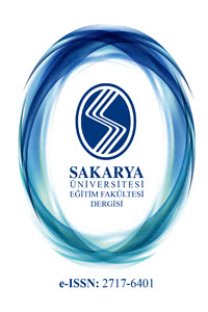TEKNOLOJİ DESTEKLİ ÖĞRETİMİN TÜRKÇE EĞİTİMİ BÖLÜMÜ ÖĞRENCİLERİ TARAFINDAN NASIL ALGILANDIĞININ İNCELENMESİ
lanılmasını ve hızla yaygınlaşmasını sağlamaktadır. Bu süreçte öğretmen ve öğrencilerin öğretim teknolojilerini kullanma becerilerinin niteliği ve seviyesi oldukça önemlidir. Eğitim sürecinde bireylerin özellikle bilişim teknolojilerine yönelik bilgi düzeyleri ve kanaatleri onların öğretim teknolojilerinden yararlanmasını etkilemektedir. Öğrenme ve öğretme ortamlarında kimin bilişim teknolojisinden nasıl, ne ölçüde yararlanabildiği önceki zamanlarda olduğu gibi bugün de sorgulanması gereken bir durumdur. Öğretmen yetiştiren kurumlarda öğrencilerin eğitimde bilgisayardan yararlanma düzeyleri ve onların bu konuda aldıkları eğitimin irdelenmesi gerekir.Türkçe Eğitimi bölümü öğrencilerinin sayısal yapı olarak algılanan bilgisayardan ne ölçüde yararlanabildiği merakı bu araştırmanın yapılmasının nedenlerinden birisidir. Bu çalışmanın amacı, Türkçe öğretmenliği bölümünde eğitim gören öğrencilerin bilgisayar destekli eğitimin derslerdeki uygulamalarına yönelik bakış açılarını tespit etmektir. Ayrıca araştırmaya katılan öğrencilerin genel görüşleriyle birlikte, kız ve erkek öğrenciler arasındaki teknoloji kullanma farklılıkları da bu çalışmada incelenmiştir. Bu çalışma, 2009-2010 eğitim öğretim döneminde Erciyes Üniversitesi Eğitim Fakültesi Türkçe Öğretmenliği Bölümü ikinci sınıfında birinci ve ikinci öğretim öğrencileriyle yapılmıştır. Anket ve açık uçlu sorular ile elde edilen veriler, hem nitel hem de nicel olarak analiz edilmiştir.
Anahtar Kelimeler:
Türkçe öğretmenliği, bilgisayar destekli öğretim, öğretmen adayları, öğretmen eğitimi
AN ANALYSIS OF PERCEPTIONS OF THE STUDENTS IN THE TURKISH EDUCATION PROGRAM ABOUT TECHNOLOGY SUPPORTED INSTRUCTION
The development in education and technology has promoted use of technology in instruction. In this integration process, the quality and level of the teachers and students’ skills of educational technology is very important. During the education, individuals’ prior experiences and their knowledge about information technologies affect their use of educational technologies. In the learning and teaching environments, who should use technology and in what level and how is still important as it was before. In the teacher preparation programs, how students are using technology and the education they have received about that should be evaluated. Thus, the one of the purpose of this study is to explore how students in Turkish education programuse computers which have mathematical structure. The main purpose of this study is to find how students in Turkish Education major views computer supported education and how computers can be used in other lessons. In addition to students overall views, this study also explored how girls and boys use technology differently. This study is conducted in 2009-2010 academic year with students in Turkish Education major (Both regular day class and night class students) at Erciyes University. The data of this study is based on survey and open-ended questions and the analysis of this data was, therefore, done with both qualitative and quantitative approaches.
Keywords:
Educational technology teacher candidates, technology integration, teacher education, Turkish Language Arts,
___
- Akpınar, Y. (1999). Bilgisayar Destekli Öğretim ve Uygulamalar, Anı Yayınclık, Ankara.
- Baytak, A. (2010). “K-12 seviyesinde e-öğrenmenin Türkiye'deki yapılabilirliği ve Öneriler”. G. T. Yamamota, U. Demiray, M. Kesim Türkiye'de E-Öğrenme Gelişmeler ve Uygulamalar. Ankara- pp-295-314. ISBN: 978-605-88891-2-5
- Chan-Lin, L. Hong, J. Horng, J. Chang, S. & Chu, H. (2006). “Factors influencing technology integration inteaching: a Taiwanese perspective”. Innovations in Education and Teaching International.43-1,(57–6).
- Cohen. D.K (1988). “Educational technology and school organization”. In R. S. Nickerson & P. Zodhiates (Eds.), Technology in education: Looking toward 2020(pp. 231-264). Hillsdale, NJ: Erlbaum.
- Dewey, J. (1916) Democracy and Education. An introduction to the philosophy of education (1966 edn.), New York: Free Press.
- Holmes, B. D. (2001). “Technology supported learning: New models for creating technology literate teachers”. ICTE Tallahassee http://www.icte.org/T01_Library/T01_218.pdf
- ISTE, (2008). International Society for Technology Education. www.iste/org
- Ivers, K. S. (2002). “Changing teachers’ perceptions and the use of technology in the classroom”. The American Educational Research Association, New Orleans, LA,
- Karasar, N. (1999). Bilimsel Araştırma Yöntemleri, Nobel Yayınları, Ankara.
- Kavcar, C.; Oğuzkan F. ve Sever S. (1993). Türkçe Öğretimi, Ankara: Engin Yayınevi.
- Kozma R. B. (2003). “Technology and Classroom Practices: An International Study”. Journal of Research on Technology in Education. 36- 1. (1-14)
- Kuo. M. (2008). “Learner to teacher: EFL student teachers' perceptions on Internet- Assisted language learning and teaching. ERIC Digest ED502217
- Mistler-Jackson, M. & Songer, N. B. (2000). “Student motivation and internet technology: Are students empowered to learn science?” Journal of Research in Science Teaching, 37(5), 459-479.
- N.R Council (1988). National Science Education Standards. Washington D.C.
- Önkaş Akış, N. (2009). “Türkçe Öğretiminde Teknoloji Kullanım ve Kalıcı Öğrenme”.K ÖĞRENME - ietc2008.home.anadolu.edu.tr (04.09.2009)
- Roberts, T. L., (2004) “Responsive instructional design in technology-supported education: A case study from the PDP”. Yayınlanmamış Tez.
- Schoepp, K.W. (2004) “Technology Integration Barriers in a Technology-Rich Environment: A CBAM Perspective”. A master thesis. ERIC Database.
- Susskind, J.E. (2005). “PowerPoint’s power in the classroom: enhancing students’ self-efficacy and attitudes”. Computers &Education . 45-2, (203-215).
- Şahin, A. Şahin E. (2009) İlköğretimde Türkçe öğretimi, (Ed. A. Kırk kılıç, H. Akyol) Pegema Yayıncılık, Ankara.
- TÜİK, (2010) Türk İstatistik Kurumu Bilgi Teknolojileri Kullanımı Anketi. http://www.tuik.gov.tr/VeriBilgi.do?tb_id=60&ust_id=2
- Wang, Y. And Holthaus, P. (1997). “Student teachers’ computer use during practicum”. In Proceedings of Selected Research and development at the 1997 National Convention of the AECT. NM, USA.
- Whetstone, L.,& Carr-Chellman, A. A. (2001). “Preparing preservice teachers to use technology: survey results”. TechTrends, 45(4 ), 11-17.
- Yıldırım A., Şimşek H. (2006) Sosyal Bilimler Nitel Araştırma Yöntemleri, Seçkin Yayıncılık, Ankara
- ISSN: 1303-0310
- Yayın Aralığı: Yılda 2 Sayı
- Başlangıç: 2001
- Yayıncı: Sakarya Üniversitesi
Sayıdaki Diğer Makaleler
ÖĞRENCİLERİN FONKSİYONLARDA İŞLEMLER KONUSUNA GRAFİKLER ÜZERİNDEN YAKLAŞIMLARININ İNCELENMESİ
İlyas YAVUZ, İbrahim KEPCEOĞLU
21. YÜZYILDA OKUL YÖNETİCİSİNİN NİTELİĞİ: ÖĞRETİM LİDERLİĞİ
ÖĞRETİM KADEMESİNE GÖRE ÖĞRENCİLERİN HİKÂYE UNSURLARINA İLİŞKİN BEKLENTİLERİ
KUŞAKLAR ARASINDAKİ İLETİŞİMDE ETKİLİ VE KALICI DİL EĞİTİMİNİN ÖNEMİ
ÖĞRENCİ SEÇME SINAVINA (ÖSS) GİRECEK ÖĞRENCİLERİN MATEMATİK İLGİSİ ÜZERİNE BİR ÇALIŞMA
AKADEMİK KOÇLUK SİSTEMİNİN ÖĞRENCİLERİN AKADEMİK BAŞARISINA ETKİSİ
